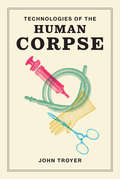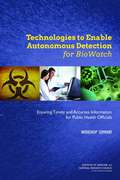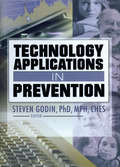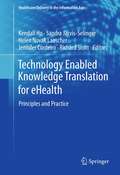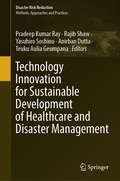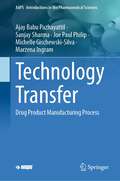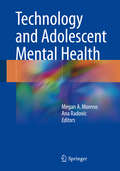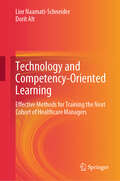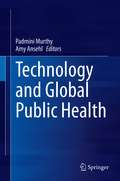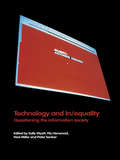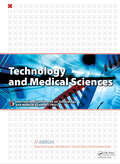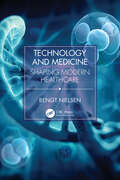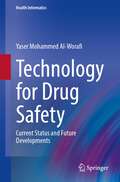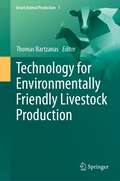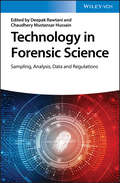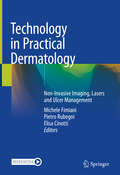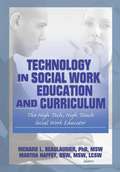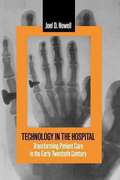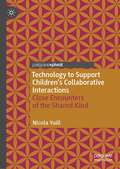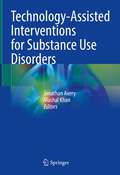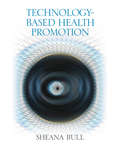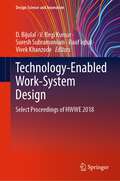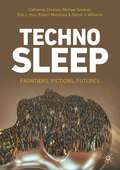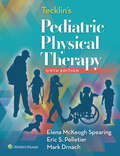- Table View
- List View
Technologies of the Human Corpse (The\mit Press Ser.)
by John TroyerThe relationship of the dead body with technology through history, from nineteenth-century embalming machines to the death-prevention technologies of today.Death and the dead body have never been more alive in the public imagination—not least because of current debates over modern medical technology that is deployed, it seems, expressly to keep human bodies from dying, blurring the boundary between alive and dead. In this book, John Troyer examines the relationship of the dead body with technology, both material and conceptual: the physical machines, political concepts, and sovereign institutions that humans use to classify, organize, repurpose, and transform the human corpse. Doing so, he asks readers to think about death, dying, and dead bodies in radically different ways. Troyer explains, for example, how technologies of the nineteenth century including embalming and photography, created our image of a dead body as quasi-atemporal, existing outside biological limits formerly enforced by decomposition. He describes the “Happy Death Movement” of the 1970s; the politics of HIV/AIDS corpse and the productive potential of the dead body; the provocations of the Body Worlds exhibits and their use of preserved dead bodies; the black market in human body parts; and the transformation of historic technologies of the human corpse into “death prevention technologies.” The consequences of total control over death and the dead body, Troyer argues, are not liberation but the abandonment of Homo sapiens as a concept and a species. In this unique work, Troyer forces us to consider the increasing overlap between politics, dying, and the dead body in both general and specifically personal terms.
Technologies to Enable Autonomous Detection for BioWatch
by Institute of Medicine National Research Council Board on Health Sciences Policy Board on Life Sciences Joe Alper Sheena M. Posey Norris India Hook-BarnardThe BioWatch program, funded and overseen by the Department of Homeland Security (DHS), has three main elements--sampling, analysis, and response--each coordinated by different agencies. The Environmental Protection Agency maintains the sampling component, the sensors that collect airborne particles. The Centers for Disease Control and Prevention coordinates analysis and laboratory testing of the samples, though testing is actually carried out in state and local public health laboratories. Local jurisdictions are responsible for the public health response to positive findings. The Federal Bureau of Investigation is designated as the lead agency for the law enforcement response if a bioterrorism event is detected. In 2003 DHS deployed the first generation of BioWatch air samplers. The current version of this technology, referred to as Generation 2.0, requires daily manual collection and testing of air filters from each monitor. DHS has also considered newer automated technologies (Generation 2.5 and Generation 3.0) which have the potential to produce results more quickly, at a lower cost, and for a greater number of threat agents. Technologies to Enable Autonomous Detection for BioWatch is the summary of a workshop hosted jointly by the Institute of Medicine and the National Research Council in June 2013 to explore alternative cost-effective systems that would meet the requirements for a BioWatch Generation 3.0 autonomous detection system, or autonomous detector, for aerosolized agents . The workshop discussions and presentations focused on examination of the use of four classes of technologies--nucleic acid signatures, protein signatures, genomic sequencing, and mass spectrometry--that could reach Technology Readiness Level (TRL) 6-plus in which the technology has been validated and is ready to be tested in a relevant environment over three different tiers of temporal timeframes: those technologies that could be TRL 6-plus ready as part of an integrated system by 2016, those that are likely to be ready in the period 2016 to 2020, and those are not likely to be ready until after 2020. Technologies to Enable Autonomous Detection for BioWatch discusses the history of the BioWatch program, the role of public health officials and laboratorians in the interpretation of BioWatch data and the information that is needed from a system for effective decision making, and the current state of the art of four families of technology for the BioWatch program. This report explores how the technologies discussed might be strategically combined or deployed to optimize their contributions to an effective environmental detection capability.
Technologische Selbstoptimierung – wie weit dürfen wir gehen? (#philosophieorientiert)
by Jan-Hendrik Heinrichs Markus RütherTechnologische Selbstoptimierung ist gegenwärtig in aller Munde. Sie umfasst die Erforschung neuer Möglichkeiten im Hinblick auf Schönheitsoperationen, funktionale Implantologie, Gehirndoping oder die Verlängerung der Lebensspanne. Gegenüber vielen dieser technischen Mittel, die oft nicht legal verfügbar sind, bestehen erhebliche gesellschaftliche Vorbehalte. Jan-Hendrik Heinrichs und Markus Rüther plädieren bei ihrer ethischen Einschätzung für eine Differenzierung der Perspektive: Die Vorbehalte sind nämlich ihrer Meinung nach nicht geeignet, gesellschaftliche Ächtung oder gar verbindliche Verbote für alle zu begründen. Vielmehr habe die Freiheit zur Selbstgestaltung Vorrang, was jedoch nicht heißt, dass es für manche Bereiche nicht auch klare Regeln geben muss. Weil Selbstgestaltung aber nur frei sein kann, wenn sie informiert ist, argumentieren die Autoren für Regelungen, die von weitgehenden Informationspflichten statt von Verboten bestimmt sind. Aus einer individuellen Sicht heraus lassen sich zudem eine Reihe von moralischen Empfehlungen formulieren, die zwar nicht eingefordert werden können, aber einen ethischen Kompass bilden, um sich im Dickicht der ethischen Debatte an guten Gründen zu orientieren.
Technology Applications in Prevention
by Steven GodinControl health care costs with these cost-effective, technology-based prevention/intervention techniques!In 2001, Americans spent $1.4 trillion on health care services. By 2010, health care costs are forecasted to approach 20% of the United States&’ Gross National Product. Technology Applications in Prevention highlights much-needed technology-based prevention/intervention methods that can help contain health costs. "Efficient and Effective Uses of Technology in Community Research" provides the information that future prevention researchers and program evaluators will need to be effective in electronic data collection, management, and cost analysis. "Community Building with Technology: The Development of Collaborative Community Technology Initiatives" presents a case example showing how Web sites can function as regional clearinghouses of useful information and provide convenient forums where agency staff can update their prevention skills. "Applying Web-Based Survey Design Standards" addresses a question critical to professionals in e-data collection: How reliable is Web-based needs assessment and/or outcome data? This chapter suggests standards that should be adhered to in Internet-based data collection. "Assessing Quality Assurance of Self-Help Sites on the Internet" and "The Quality of Spanish Health Information Web Sites: An Emerging Disparity" address the current lack of quality in the health and mental health information available on the World Wide Web. "A Participatory Internet Initiative in an African-American Neighborhood" explores health disparity concerns regarding the use of the Internet. This chapter discusses several ways to empower those who are on the dark side of the "digital divide"-and shows how to ensure that Web-based material is culturally relevant and appropriate for those it is intended to help. "Alcohol Abuse Prevention Among High-Risk Youth" presents a case example of a life-skills based CD-ROM intervention designed to discourage kids from abusing alcohol. "Constructing Better Futures Via Video" looks at video-based futures planning, which combines self-modeling and "feedforward" to forecast a student&’s future capabilities. This technique helps teenagers find meaning in their current educational setting and prepare for adulthood. This chapter also explains how to train school-based personnel to encourage positive attitudes and support the life skills of their students via carefully planned and edited-yet inexpensive-video productions.Why is the information in this book so essential? In 2000, approximately 20% of U.S. employers changed their health insurance plans as a cost savings strategy. American companies and their employees must new deal with new insurance plans that have reduced the breadth of their coverage and/or increased employee deductibles. The need for cost-effective preventive strategies is becoming increasingly more urgent as employers and insurance companies scramble to provide affordable health care coverage. New technologies have opened the door to better, more economical modes of preventive care. This book presents a vital cross-section of the current state of the art in the application of technology to prevention and intervention. Make it a part of your professional/teaching collection today!
Technology Enabled Knowledge Translation for eHealth
by Sandra Jarvis-Selinger Helen Novak Lauscher Richard Scott Jennifer Cordeiro Kendall HoRapid progress in health research has led to generation of new knowledge and innovative practices in management of illness. This has resulted in a significant challenge for health professionals: if today we discovered a new therapy through research, when will this discovery be regularly prescribed or utilized to treat all patients suffering from this condition? Knowledge translation is the non-linear and often complicated process of translating knowledge into routine health practices. Technology enabled knowledge translation (TEKT) is the use of information and communication technologies (ICT) to accelerate knowledge translation. With the ubiquity of the internet, the proliferation of different approaches in communication and social networking, and the continuously improving technologies from netbooks to smartphones, there are rich opportunities for TEKT in health education, service delivery, and research.
Technology Innovation for Sustainable Development of Healthcare and Disaster Management (Disaster Risk Reduction)
by Anirban Dutta Rajib Shaw Pradeep Kumar Ray Yasuhiro Soshino Teuku Aulia GeumpanaThis book provides holistic case studies of technology development, examples of its complexities and an in-depth analysis from the perspective of information infrastructure. Natural disasters such as cyclones, tsunamis, earthquakes and volcanoes have disrupted the lives of people all over the world, particularly in Asia. In order to manage disasters and mitigate the damage, many technologies—surveillance systems, for instance—have been developed. An example of natural disaster is the ongoing devastation caused by COVID-19, which highlights the multi-disciplinary nature of disaster management, including agriculture, healthcare, economics, environment, engineering and technology. The pandemic has also led to the development and uptake of technologies such as vaccine development, new biotechnological innovations, telemedicine, the Internet of things (IoT) and mobile health (mHealth) all over the world. The United Nations Sustainable Development Goals (SDGs) programme suggests an integrated approach to their development. For example, healthcare needs to be addressed in holistic perspectives including education, environment, economy and regulations, among others. These goals create challenges in the development, validation and deployment of new technology, with this book presenting a discussion of innovations in sustainable development of healthcare in the multi-disciplinary context of SDGs.
Technology Transfer: Drug Product Manufacturing Process (AAPS Introductions in the Pharmaceutical Sciences #10)
by Sanjay Sharma Ajay Babu Pazhayattil Marzena Ingram Joe Paul Philip Michelle Gischewski-SilvaCurrently, there are no textbooks on drug product manufacturing technology transfer that incorporate the latest regulatory expectations. Recent guidance from regulatory bodies such as the US FDA, EMEA, WHO, and PIC/S has adopted the ICH Lifecycle approach harmonizing concepts across regulatory guidance. This allows organizations to align their technology transfer activities for all regulated markets. However, there is a need for consensus and direction in approaching technology transfer, particularly in understanding how to manage the scale-up effects to ensure regulatory compliance.This textbook offers technology transfer solutions and guidance to the pharmaceutical industry. The chapters provide a systematic understanding of applying the technology transfer concepts in pharmaceutical manufacturing, promoting standardization within the industry. Since Stage 1b is not specified in detail within the regulations, pharmaceutical organizations are left to determine the requirements of the stage. The need to justify the methodologies and utilization of sound science makes it more demanding. The textbook’s authors provide innovative solutions for technology transfer challenges, making it a comprehensive reference document. The approaches can be applied to both small-molecule and large-molecule drug product manufacturing segments, addressing the unmet needs of the industry.
Technology and Adolescent Mental Health
by Megan A. Moreno Ana RadovicThis comprehensive book provides a framework for healthcare providers working with the dual challenges and opportunities presented by the intersection of mental health and technology. Technology and Adolescent Mental Health provides recent, evidence-based approaches that are applicable to clinical practice and adolescent care, with each chapter including a patient case illustrating key components of the chapter contents. Early chapters address the epidemiology of mental health, while the second section of the book deals with how both offline and online worlds affect mental health, presenting both positive and negative outcomes, and focusing on special populations of at-risk adolescents. The third section of the book focuses on technology uses for observation, diagnosis or screening for mental health conditions. The final section highlights promising future approaches to technology, and tools for improving intervention and treatment for mental health concerns and illnesses. This book will be a key resource for pediatricians, family physicians, internal medicine providers, adolescent medicine and psychiatry specialists, psychologists, social workers, as well as any other healthcare providers working with adolescents and mental health care.
Technology and Competency-Oriented Learning: Effective Methods for Training the Next Cohort of Healthcare Managers
by Dorit Alt Lior Naamati-SchneiderThis book provides insights into the development of competency-based learning approaches and specific instructional activities designed to enhance healthcare management students’ twenty-first-century skills (21CS). These skills encompass three core domains: cognitive, intra-personal, and inter-personal. The book explores how these skills can be advanced within the intricate dynamics of healthcare systems at macro, meso, and micro levels, emphasizing the imperative need for healthcare professionals to adapt to rapid technological and global changes. Structured into twelve chapters, the book begins with an overview of the complex healthcare environment, highlighting transformative changes and challenges. It then delves into the core theme of competency-based learning, showcasing a shift from traditional teaching methods to constructivist approaches that enhance real-world skills through interactive methods. This approach is crucial for fostering the necessary skills in healthcare managers and other healthcare professionals, which are increasingly vital in today's digital and dynamic medical landscape. The book serves as an extensive resource and guide for healthcare students, faculty, researchers, curriculum designers, policymakers, and current and future healthcare leaders. It offers practical methodologies, innovative teaching methods, and insightful case studies, making it a valuable reference for healthcare and pedagogical research.
Technology and Global Public Health
by Padmini Murthy Amy AnsehlThis book explores the pivotal role played by technology over the past decade in advancing global public health and health care. At present, the global community faces unprecedented healthcare challenges fueled by an aging population, rising rates of chronic disease, and persistent health disparities. New technologies and advancements have the potential to extend the reach of health professionals while improving quality and efficiency of service delivery and reducing costs within the public and the private health systems. The chapters highlight the barriers faced by the global healthcare workforce in using technology to promote health and human rights of communities:Role of Digital Health, mHealth, and Low-Cost Technologies in Advancing Universal Health Coverage in Emerging EconomiesTelehealth and Homecare AgenciesTechnology and the Practice of Health Education in Conflict ZonesThe Worldwide Digital Divide and Access to Healthcare TechnologyTechnology for Creating Better Professional Teams to Strengthen Healthcare SystemsGlobal Public Health Disaster Management and TechnologyAs a resource on the evolution of technology as a valuable and integral component in the promotion and practice of public health and health care, with a focus on SDG 3 targets, Technology and Global Public Health should engage students, instructors, practitioners, and other professionals interested in public health, universal health care, health technology, digital health, and health equity.Dr. Murthy has been a respected leader and mentor on scientific health-related matters within the UN system for many years. Her book develops a theoretical system connecting concepts that have coined global public health with the rapid development of technology, all with the focus to achieve Sustainable Development Goal number three, within the time frame set by World Leaders. - Henry L. Mac-Donald, Former Permanent Representative of Suriname to the United Nations
Technology and In/equality: Questioning the Information Society
by Sally Wyatt Nod Miller Flis Henwood Peter SenkerTechnology and In/equality explores the diverse implications of the new information and communication technologies through case studies of their applications in three main areas - media, education and training, and work. Questions of access to and control over crucial resources such as information, knowledge, skills and income ae addressed drawing upon insights from science and technology studies, innovation theory, sociology and cultural studies. All of the chapters question the meanings of the terms 'technology' and 'inequality' and of the widespread association of technology with progress. Written with a non-specialist readership in mind, all complex theories and key concepts are carefully explained making the book easily accessible and relevant to a wide range of courses.
Technology and Medical Sciences
by João Manuel R.S. Tavares R.M. Natal JorgeThe use of more robust, affordable, and efficient techniques and technologies in the application of medicine is presently a subject of huge interest and demand. Technology and Medical Sciences solidifies knowledge in the fields of technology and medical sciences and to define their key stakeholders. The book is designed for academics in engineering, mathematics, medicine, biomechanics, computation sciences, hardware development and manufacturing, electronics and instrumentation, and materials science.
Technology and Medicine: Shaping Modern Healthcare
by Bengt NielsenTaking a holistic approach, this book describes the developments in medicine and medical technology from ancient times to modern days. It is an exciting journey where readers will learn about the many great inventions by people that did not take the knowledge of their times as a fact. They challenged mysticism, beliefs, the religion, and the Church. They were true scientists long before we knew how to define what a scientist is. This book is, in a way, connecting the dots between the past and the future within healthcare. Features * Provides details on further developments that gave new and exceptional information for diagnostic or therapeutic purposes Gives the reader a new perspective and a common thread of life on medicine and MedTech as well as an improved understanding of how far we have come and how much there still is to work on before we fully understand the human body and its functionality Discusses and gives insight into ongoing research projects that could become clinically available in the future
Technology for Drug Safety: Current Status and Future Developments (Health Informatics)
by Yaser Mohammed Al-WorafiThis book presents information about the use of technology to support the prevention and management of drug safety issues: pharmacovigilance (PV), medication errors, drug-related problems (DRPs), counterfeit medicines and other drug safety issues. Adapting new technologies/information technologies, mobile technologies and social media has contributed effectively to safety practices for medications, with this book providing comprehensive information as a guide to its challenges and potential. Technology for Drug Safety provides practicing and trainee pharmacists, pharmacy technicians, pharmacy educators, researchers, public health policy makers, healthcare professionals and medical educators with vital information about the impact of technology on drug safety-related issues. It describes the current status of the practice, the challenges in the field and recommendations for the effective use of technology in drug safety practice including clinical trials and drug development, PV, detection of adverse drug reactions, reporting and management, medication errors detection, reporting and management, DRPs, counterfeit and substandard medications, and other safety issues.
Technology for Environmentally Friendly Livestock Production (Smart Animal Production)
by Thomas BartzanasThis volume compiles state-of-the-art scientific knowledge on the technologies that are used to quantify and reduce the environmental impact of livestock production in the cattle, pig and poultry industries. It makes a serious statement about how such technology can contribute to the sustainability of the livestock industry in the future.As the global livestock sector is growing, modern farm animal production is increasingly regarded as a source of solid, liquid, gaseous and dust emissions, which can be both nuisance and environmentally harmful. In light of hardening regulations and social pressure, there is increasing interest in scientific research on air pollution and emissions from livestock operations.The present chapters focus on methodology improvement, harmonization of measurements, and modeling aspects. Key aspects, such as renewable energy sources, nutritional approaches to reduce enteric methane emissions, technical options for manure management, and the use of sensors, are covered. By sharing good practices, this book is a valuable reference for a diverse readership. Experts across the veterinary and animal sciences, agricultural engineering, the food industry and sustainability research will benefit from the findings.
Technology in Forensic Science: Sampling, Analysis, Data and Regulations
by Deepak RawtaniThe book "Technology in Forensic Science" provides an integrated approach by reviewing the usage of modern forensic tools as well as the methods for interpretation of the results. Starting with best practices on sample taking, the book then reviews analytical methods such as high-resolution microscopy and chromatography, biometric approaches, and advanced sensor technology as well as emerging technologies such as nanotechnology and taggant technology. It concludes with an outlook to emerging methods such as AI-based approaches to forensic investigations.
Technology in Practical Dermatology: Non-Invasive Imaging, Lasers and Ulcer Management
by Elisa Cinotti Michele Fimiani Pietro RubegniThis book provides a complete overview on the latest available technologies in dermatology, while discussing future trends of this ever-growing field. This handy guide provides clinicians and researchers with a clear understanding of the advantages and challenges of laser and imaging technologies in skin medicine today. It also includes a section on imaging techniques for the evaluation of skin tumors, with chapters devoted to dermoscopy, in vivo and ex vivo reflectance confocal microscopy, high frequency ultrasound, optical coherence tomography, and a closing part on latest approaches to wound management.Completed by over 200 clinical images, Current Technology in Practical Dermatology: Non-Invasive Imaging, Lasers and Ulcer Management is both a valuable tool for the inpatient dermatologist and for physicians, residents, and medical students in the field.
Technology in Social Work Education and Curriculum: The High Tech, High Touch Social Work Educator
by Florence W Vigilante Richard L Beaulaurier Martha F HaffeySave time and trouble as you incorporate technology into your social work curriculumThe dramatic increase in the use of computers and other forms of technology in social work education and practice has educators, trainers, and administrators investing valuable time, money, and effort into trying to make the transition from traditional teaching to a Web-assisted learning environment. Technology in Social Work Education and Curriculum takes the mystery out of the online experience with practical information on using technology to enhance and enrich learning-but not at the expense of the "human" approach to social work. This unique book presents a variety of creative and interesting methods for incorporating technology that&’s affordable and user-friendly, and for developing online skills that won&’t become obsolete as computer hardware and software evolves.Technology in Social Work Education and Curriculum transforms technology into an everyday resource for agency field instructors, human service educators, trainers, and social work administrators. The book addresses concerns that educators with limited technical skills may have in using technology to teach cultural competency, group work, research, direct practice, social policy and advocacy, and field practicum, presenting hands-on approaches that are innovative but accessible. And by focusing on approaches rather than simply reviewing available hardware and software, the book provides you with background knowledge that makes it easier for you to successfully incorporate online learning into the classroom. Technology in Social Work Education and Curriculum examines using instructional technology to emotionally engage students in the learning process using digital video and qualitative data analysis software to teach group practice the role technology plays in advocacy distance-education technologies in policy education incorporating Web-assisted learning into a traditional classroom setting the advantages of distance education over more conventional approaches a model for planning the use and integration of computer technology in schools of social work how the behaviors of computer consultants can affect the students who seek their help using innovation diffusion theory in technology planning and much more!Social workers have traditionally embraced the latest technologies and scientific developments since the earliest days of the profession. Technology in Social Work Education and Curriculum helps continue that tradition, offering invaluable guidance to educators and administrators, no matter how experienced-or inexperienced-they are in dealing with communications technologies.
Technology in the Hospital: Transforming Patient Care in the Early Twentieth Century
by Joel HowellPhysicians, Patients, and Medical Technology, Science, Scientific Systems, and Surgery, The Changing meaning of Urinalysis, Clinical use of the X-Ray Machine, The X-Ray Image, Blood and Blood Counts, Blood and Diseases, Machines and Medicine.
Technology to Support Children's Collaborative Interactions: Close Encounters of the Shared Kind
by Nicola YuillThis book explores how technology can foster interaction between children and their peers, teachers and other adults. It presents the Co-EnACT framework to explain how technology can support children to collaborate, so helping them to learn and engage enjoyably with the world, in both work and play. The focus is on children, rather than young people, but the principles of supporting interaction apply throughout all life stages. Chapters on classrooms and on autism explain principles behind using technology in ways that support, rather than obstruct, social interaction in diverse populations. Collaborative interaction involves both verbal and non-verbal behaviour and this book presents evidence from closely analysing children’s behaviour in natural settings. Examples from cutting-edge technology illustrate principles applicable to more widely-available technology. The book will be of interest to psychologists, educators, researchers in Human–Computer Interaction (HCI), particularly those designing with children in mind, and practitioners working with children who want to deepen their understanding of using technology for collaboration.
Technology-Assisted Interventions for Substance Use Disorders
by Jonathan Avery Mashal KhanThis book examines the role of technology-assisted interventions for substance use disorders (SUD). It considers this topic alongside the dramatic increase in SUDs and associated harm in the United States’ past decade.Chapters relay the impact and effectiveness of technology-assisted interventions, which include telemedicine, assisted therapies, and support. These treatments not only offer practical care but also address the issue of access to care, particularly in the wake of the global pandemic (COVID-19). Organized into three sections, section one covers the use of telemedicine and technology-assisted therapies as it relates to the treatment of various SUDs, achieving recovery and maintenance. Each chapter will expand on a specific aspect of technology-assisted intervention. Following this, section two explores the differences in technology-assisted interventions and approaches while taking into account age, gender, sexuality, identity, and psychosocial factors. This section will be divided into chapters on children and adolescents, women and pregnancy, older adults, LGBTQIA+, and professionals. To close the book, section three discusses the media impact on SUDs and the legal technology adopted by drug courts.Unique and timely, Technology-Assisted Interventions for Substance Use Disorders is an invaluable resource to learners and practitioners in the field. It provides a concise yet comprehensive summary of the current status of the field that will help guide the implementation of technology-assisted interventions for all SUDs into practice and stimulate investigative efforts.
Technology-Based Health Promotion
by Dr Sheana BullThis is the first textbook of its kind to offer students an introduction to best practices for using technology in health promotion programs. Integrating detailed case studies and interactive skill-building exercises throughout, this succinct and practical text teaches students to identify the most appropriate technology to meet their goals.
Technology-Enabled Work-System Design: Select Proceedings of HWWE 2018 (Design Science and Innovation)
by Rauf Iqbal Vivek Khanzode Bijulal D. Regi Kumar V Suresh SubramoniamThis volume presents selected papers presented during the 16th International Conference on Humanizing Work and Work Environment (HWWE 2018). The book presents a confluence of ideas on ergonomics and technology implementation to improve workplace environments and work systems to maximize effectiveness and performance. The volume is thematically arranged, with papers covering different aspects of ergonomics and design. The volume will be of use to researchers, practitioners and students working in different fields of ergonomics.
Technosleep: Frontiers, Fictions, Futures
by Simon J. Williams Robert Meadows Michael Greaney Eric L. Hsu Catherine CoveneyThis book draws on a variety of substantive examples from science, technology, medicine, literature, and popular culture to highlight how a new technoscientifically mediated and modified phase and form of technosleep is now in the making – in the global north at least; and to discuss the consequences for our relationships to sleep, the values we accord sleep and the very nature and normativities of sleep itself.The authors discuss how technosleep, at its simplest denotes the ‘coming together’ or ‘entanglements’ of sleep and technology and sensitizes us to various shifts in sleep–technology relations through culture, time and place. In doing so, it pays close attention to the salience and significance of these trends and transformations to date in everyday/night life, their implications for sleep inequalities and the related issues of sleep and social justice they suggest.
Tecklin's Pediatric Physical Therapy
by Elena McKeough Spearing Eric S. Pelletier Mark DrnachTrusted for decades by Physical Therapy students as well as experienced therapists who want to improve their knowledge, Tecklin’s Pediatric Physical Therapy provides a comprehensive and logical overview of some of the most common pediatric physical therapy diagnoses. This straightforward approach presents basic medical information regarding common clinical diagnostic categories followed by coverage of physical therapy examination, intervention and special considerations within each diagnostic group. Content in this 6th Edition has been thoroughly updated and reorganized to help prepare students for today’s clinical challenges, accompanied by case studies and interactive features that reinforce understanding and instill the clinical decision-making skills essential to successful practice.
